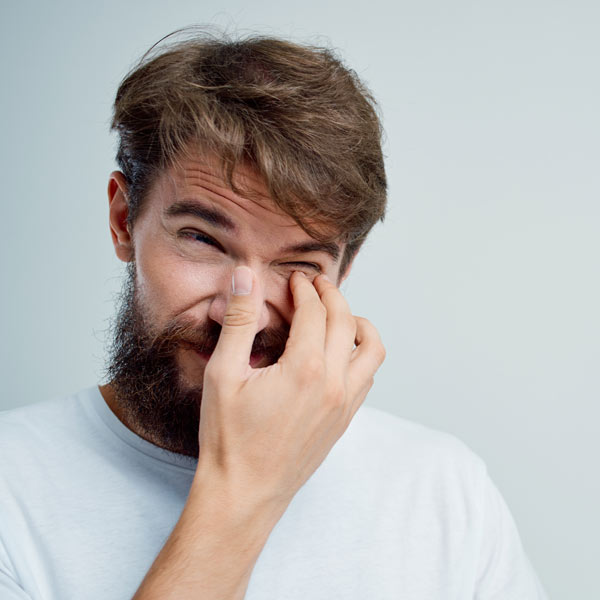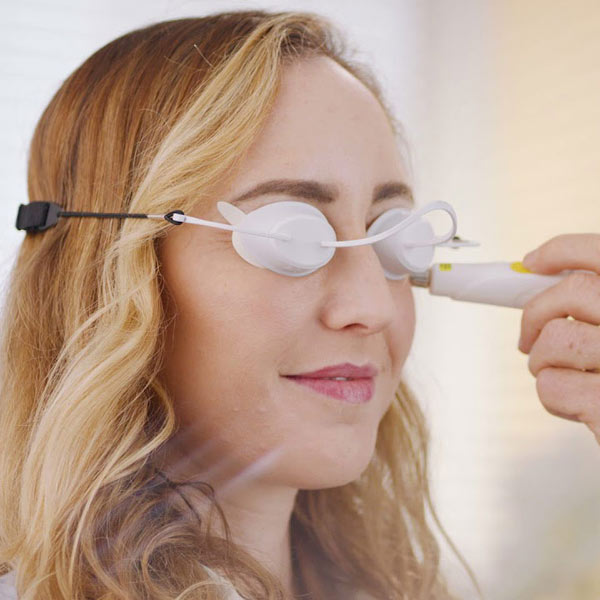Dry Eye
Center
New Hartford Eye Associates 860-379-7183
Avon Vision Associates 860-677-6444

Symptoms

Causes

Evaluation

Treatments

Dry Eye Store

Referring Doctors

Symptoms

Causes

Evaluation

Treatments

Dry Eye Store

Referring Doctors
Dry eye specialists in New Hartford & Avon, CT
Dry eye disease is a common condition that occurs when the eyes don’t produce enough tears or the tears evaporate too quickly. Our dry eye specialists in New Hartford and Avon, Connecticut are experienced in diagnosing and treating dry eye disease, providing lasting relief for our patients.

What are the symptoms of dry eye disease?
Symptoms of dry eye disease can range from mild to severe and may include:
- Eye discomfort or pain
- A burning or stinging sensation in the eyes
- Itching
- Redness
- A gritty feeling in the eyes
- Blurred vision
- Sensitivity to light
- Increased tear production (watery eyes)
In addition to causing discomfort, dry eye disease can also lead to more serious problems such as corneal ulcers, infections, and scarring.
What causes dry eye disease?
There are many different reasons people can develop dry eye disease, so if you’re experiencing symptoms of dry eye disease, it’s important to get a customized evaluation of the underlying causes to effectively treat it.
Meibomian gland dysfunction
Meibomian gland dysfunction (MGD) is a condition in which the meibomian glands, located in the eyelids, become clogged or blocked.
Learn more
These glands produce an oily substance that helps to lubricate the eye and prevent tear evaporation. When these glands become blocked, the production of this oily substance is reduced or stopped, leading to an imbalance in the tear film and dry eye symptoms.
MGD is one of the top underlying causes for dry eye disease and is particularly prevalent in people who have a history of blepharitis or eyelid inflammation. Symptoms of MGD can include eye discomfort, redness, a feeling of grittiness, and a sensation of burning or stinging. In severe cases, MGD can also lead to thickened, irregular eyelid margins and meibomian cyst (chalazion) formation.
Certain medical conditions
Certain medical conditions, such as rheumatoid arthritis and Sjogren’s syndrome, can lead to dry eye disease.
Medications
Certain medications, such as antihistamines and antidepressants, can also cause dry eyes as a side effect.
Environmental factors
Environmental factors such as wind, sun, and air conditioning can also contribute to dry eyes.
Digital eye strain
People who spend long hours in front of a computer screen or other digital devices may experience dry eye symptoms as the blink rate decreases.
Blepharitis
Blepharitis is a condition in which the eyelids become inflamed. It is a common condition that affects the eyelids and can cause a variety of symptoms including redness, itching, burning, and a feeling of grittiness in the eyes.
Learn More
It can also cause the eyelashes to become matted or to turn inward, which can lead to irritation and even infection.
Blepharitis can be caused by several factors, including a bacterial infection, an overgrowth of normal eyelid bacteria, or an allergic reaction. It can also be caused by a blockage in the oil glands located in the eyelids, which can lead to dry eye disease. It is thought that inflammation caused by blepharitis can damage the oil glands in the eyelids, leading to a decrease in the production of the oily layer of tears that helps to keep the eyes lubricated. This can lead to dryness and irritation, which can then make the blepharitis worse, creating a vicious cycle.
Cosmetics
Some ingredients in cosmetics can be irritating to the eyes, leading to dryness, redness, and itching. These ingredients include preservatives, fragrances, and certain types of dyes.
learn more
For example, eye makeup, such as mascara and eyeliner, can contain ingredients that can cause irritation and dryness, especially if the makeup is worn for long periods of time.
Cosmetics may also contribute to the development of blepharitis by clogging the oil glands in the eyelids, which can lead to an overgrowth of bacteria and inflammation.
Another possible way that cosmetics can cause dry eye is by blocking the tear ducts, which is a channel that carries away the tears from the eyes. This blockage can cause the tears to build up in the eyes, leading to dryness and irritation.
Demodex mites
One of the possible causes of blepharitis and dry eye disease is an infestation of tiny mites called Demodex. These mites are normally found on human skin, but when they occur in large numbers on the eyelashes, they can cause inflammation of the eyelids, leading to symptoms such as redness, itching, and a feeling of grittiness in the eyes.
learn more
This inflammation can also cause damage to the oil glands in the eyelids, which can lead to dry eye disease.
Demodex mites are found on many people and are considered normal. However, an infestation may happen when the number of mites exceeds the normal limit. An infestation of mites can be caused by weakened immunity, genetic predisposition, or excessive oil production which makes the environment more suitable for mites to flourish. The diagnosis of Demodex infestation is usually made by examination of an eyelash under a microscope, which will reveal the presence of the mites.
How is dry eye diagnosed?
The doctors at Avon Vision Associates and New Hartford Eye Associates use advanced diagnostic technology to evaluate patients for dry eye disease. If you are experiencing symptoms, we can diagnose dry eye disease and the underlying cause for your specific case.
In addition to a comprehensive eye exam, we will conduct these tests during your evaluation:
TearLab
The TearLab Osmolarity System is designed to help diagnose dry eye disease by measuring the osmolarity, or concentration of dissolved substances, of a patient’s tears. This diagnostic tool is meant to be used alongside other clinical evaluations to confirm or rule out dry eye disease in patients suspected of having the condition.
Meibography
Meibography is a diagnostic imaging technique used to visualize the meibomian glands of the eyelids. The meibomian glands are in the eyelids and are responsible for producing the oily layer of the tear film that helps to keep the eyes lubricated.
learn more
They are an important part of the tear film and when the glands are blocked or not functioning properly, it can lead to dry eyes.
Meibography is performed by taking an imaging of the eyelid margins with a special infrared camera called the Firefly Slit Lamp. The camera allows the meibomian glands to be visualized and evaluated for size, shape, and position and also the degree of obstruction. This is important in determining the quality of the oils they are secreting.
Meibography is a non-invasive and painless procedure. It can be performed as an office-based procedure that allows for a detailed assessment of the meibomian glands and can help to identify any problems with the glands such as clogging or shrinkage. It can also provide valuable information to aid in the treatment of dry eye disease and meibomian gland dysfunction.
InflammaDry
InflammaDry is a unique, in-office test that allows for quick detection of dry eye disease by measuring elevated levels of MMP-9, an inflammatory marker found in the tears of patients with dry eye disease. This test is the first and only one of its kind.
learn more
Unlike other dry eye tests that focus on measuring tear production and stability, InflammaDry utilizes a 4-step process to specifically identify patients with elevated levels of MMP-9, thus providing an alternative for patients who may have been overlooked by traditional testing methods.
Schedule a dry eye exam in Avon or New Hartford, CT
If you’re dealing with dry eye symptoms like irritation and redness, schedule a dry eye exam in New Hartford or Avon! We look forward to seeing you soon. Request your evaluation for dry eye disease by contacting our office at info@avonvision.net.
Dry eye treatment in New Hartford & Avon, CT
Our eye doctors at Avon Vision Associates and New Hartford Eye Associates have expertise in diagnosing and treating dry eye disease.
Using advanced diagnostic testing, our eye doctor will gather the information needed to determine if you have dry eye disease. We utilize the Firefly WDR slit lamp microscope, which enables us to accurately judge the absence of meibomian glands, obtain tear film breakup time, analyze eye surface damage and inflammation, and evaluate tear meniscus height.
If a diagnosis is made, your doctor will work with you to develop a treatment plan tailored to your unique vision and ocular health needs.
Dry eye can vary in severity from person to person, as everyone is different. We offer safe and effective treatment solutions for dry eye. These can include eye drops, lifestyle adjustments, and other strategies designed not just to treat your symptoms, but to address the source of the issue. This means your treatment is more sustainable, allowing you to live a comfortable, high-quality life.
We also provide dry eye treatment in our office. Your eye doctor will recommend one or more of these treatments, based on the underlying causes of your dry eye and what will best suit your needs. Learn more about these treatments!



